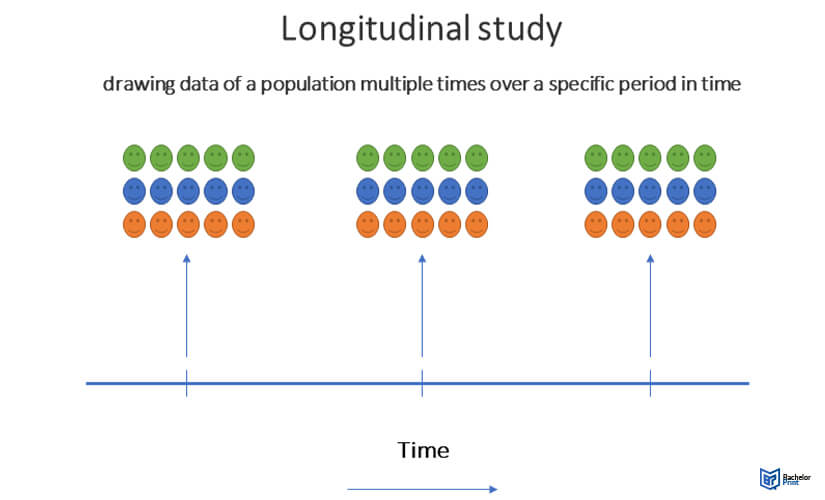
When conducting a study, one may distinguish between two major divisions: observational studies and experimental studies. Observational studies involve studying lives and processes within an area of interest without interfering with the variables or conditions directly linked to the subject under study. Descriptive studies, ecological studies, cohort studies, as well as cross-sectional studies, are all methodologies based on an observational approach. Conversely, experimental studies involve manipulating variables or conditions to achieve specific results.
Definition: Cross-sectional study
A cross-sectional study, also known as a prevalence study, is widely used in studying the prevalence of diseases in populations. It involves collecting data and establishing a correlation between a potential risk factor and an outcome at a particular point in time.
Cross-sectional study vs. Longitudinal study
Cross-sectional studies focus on drawing data from a population at a particular point in time, where in contrast, longitudinal studies draw data of a population multiple times over a specific period in time. This means that it is essential to choose the most suitable type of study for different types of research. In many cases, cross-sectional studies are useful in collecting fundamental data, whereby important links and correlations are evaluated. Thereon, longitudinal studies can be carried out to study these correlations even further.


As an example, you may conduct a cross-sectional study on the impact that parents from different income levels have on the grades of their children in elementary school. If you, for instance, evaluate that children with parents from higher income levels, perform better in elementary school, a correlation is concluded. Thereon, you can carry out a longitudinal study to further study the better performance of children in elementary school with parents from a higher income level, as your cross-sectional study has provided this correlation.
Descriptive vs. Analytical studies
Cross-sectional studies may be based on an analytical or a descriptive approach:
Analytical cross-sectional study – examines correlations and links between different variables.
Descriptive cross-sectional study – a general summary of the research findings with no hypotheses. Mainly aims to assess the prevalence of an outcome in a defined population.
Cross-sectional study – A guide
- Identify a study area, research question, or niche
The first step toward carrying out research is to have a problem that calls for research. Once a gap has been established, for example, a research question looks to investigate the prevalence of addiction within individuals of a particular age group in the United States. Having this question will steer the research further.
- Identify a population and recruit participants
Identify a population, which in the process of taking a sample, accommodates individuals from different races, cultures, ethnicities, religious backgrounds, economic statuses, and genders. It is also vital that the population that is analyzed, is an appropriate size.
A large sample may offer variety and ensure that enough data can be collected. In relation to this, the likelihood to identify patterns and correlations may be much higher. In terms of recruiting participants, the most critical factor for a study is that the participation is voluntary and consent has to be given. It is considered an offense if participants are forced to take part.
- Collect and record data
After you have a group to work with, identify individuals exposed to the risk factor and those not; from this, you can collect information on the outcomes and exposures individually and simultaneously.
Methods of data collection in a cross-sectional study:
- Questionnaires
- Surveys
- Interviews
- Physical measurement, i.e. medical equipment, etc.
When is a cross-sectional study suitable?
A cross-sectional study is most applicable, when…:
-
- you are working with a considerably large population, and you need a less expensive alternative to conduct a study.
- the exposure or variable is constant or undergoes a prolonged change, for example, genetics.
A cross-sectional study is irrelevant to use, when…:
-
- you study rare occurrences in a population.
- you want to establish a pattern in a population.
- you intend to establish a causal relationship between exposure and an outcome during the study. This may be very difficult, if not impossible, to establish using a cross-sectional study design.
A cross-sectional study is conducted at a specific time, which makes it difficult to determine whether the exposure or the outcome came first and if their occurrences are linked in any way.
For example, when studying a disease prevalence in a population, the samples may be grouped as in the following:
-
- Those exposed but not infected
- Those exposed and infected
- Those not exposed but infected
- Those not exposed and not infected.
This case illustrates that it is difficult to know why one is not exposed and not infected or why one is exposed yet not infected. As there is no underlying evidence, it cannot be assumed that one was infected by exposure…etc.
Pros and cons of a cross-sectional study
In the following, we account for the advantages and disadvantages of cross-sectional studies.
Advantages of using a cross-sectional study
A cross-sectional study is one of the most cost-effective forms of research. Therefore, researchers, who seek inexpensive research options may benefit from this type of research. In addition, it is less time-consuming than other studies, as data is collected only once at a defined point in time. It does not only allow you to collect all required variables but also to assess multiple outcomes at the same time. Furthermore, it is very effective, when used in a descriptive approach, as it measures the prevalence of all risk factors and, as a result, provides correlations for further research.
Disadvantages of using a cross-sectional study
As a cross-sectional study is conducted only once, the collected data may be insufficient to analyze behavior and relationships between parameters. It is impossible to determine a link between the outcome and the risk factor. Regarding this, it is also impossible to assess long-term patterns and trends, as the study is conducted over a particular moment. As there is no information prior to and post the study was conducted, the short time frame may make the research inaccurate and not always representative.
A cross-sectional study may be subject to report bias. Any form of bias will primarily affect the data collected during a cross-sectional study. Selection bias may occur depending on who answered and who did not. In contrast, information bias is based on the validity and reliability of the collected data and methods used.
To measure validity in a cross-sectional study, the researcher may ask:
- Do the questions measure what we want to measure?
- Are the words ambiguous and may be misinterpreted, if so, can they be translated?
To measure reliability in a cross-sectional study, the data collection method must be verified. The researcher may ask:
- Will the questionnaire produce similar results if used for a similar situation, group of people, and during a similar time?
To avoid bias, the questionnaire should be able to lead to similar outcomes in similar scenarios.
When working with convenience-based samples, another bias may occur. A cross-sectional study has no specific guidelines for sampling. If researchers did not thoroughly analyze and thus, collect non-accommodating samples, the collected data may be in favor of a particular group.
FAQs
A cross-sectional study is an observational research design, where a group of participants or a population is studied at a particular point in time. A longitudinal study entails repeated observations of the same group of participants or population over specific periods in time.
It has the advantage of studying and comparing a variety of variables simultaneously. Furthermore, it allows the researcher to detect more correlations for more research.
As cross-sectional studies focus on studying characteristics of variables at a specific point in time, they are not able to assess behaviors and relationships between variables over an extended period in time.
The structure of a cross-sectional analysis includes the following steps:
- Setting up the research goals
- Defining the variables
- Identifying the cross-section
- Establishing the specific point in time
